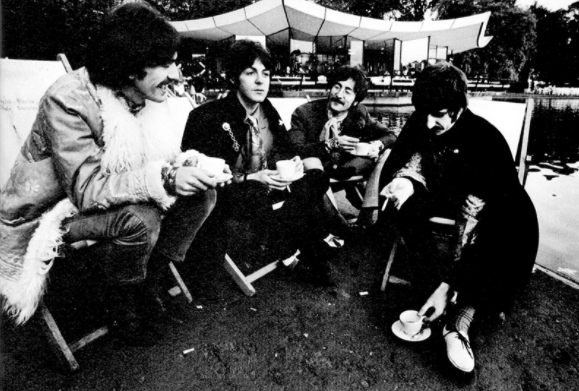Twine Story: A Beatles Reunion
In the year 2050, The Beatles gather in Heaven to go over fond memories, not before dealing first with some appearance issues established by God.
Download the Twine Story here:
A Beatles Reunion.html

Creating the Twine story for Task 5 reminded me of the design process described by Brennan and Resnick (2013), which is defined as an iterative phenomenon that involves cycles of imagining, creating, playing, sharing, and reflecting. I had never used Twine or experimented much with storytelling, however, I have lots of experience in using software applications to create artifacts (music, video, animation, websites, graphics, etc), so I was able to push through the periods of stagnation in the design process, going through the different cycles described by Brennan and Resnick (2013) until achieving the final result. Creating the Twine story was very similar to the process of producing music or doing a video animation. I had to use my creativity to organize ideas logically in a time frame, experiment, make mistakes, learn software tricks, and re-invent ideas. The translation of my creative software abilities into Twine made me think about Englebart’s (1963) H-LAM/T system and his observation that “each individual develops a certain repertoire of process capabilities from which he selects and adapts those that will compose the process that he executes” (p.11).
Through producing music, I’ve learned that it is not helpful to stay much time in the imagining stage and it’s better to dive into the creating and playing stages (with a few rough ideas, of course). In Nike’s words, just to do it. When creating the Twine story I was tempted to get stuck or spend too much time in the imagining stage, particularly after having the idea playing with the concept of a Beatles’ story. However, at some point, I realized it was just a matter of getting things started and see where I was going to be led. In fact, the initial idea I had for the story was different (a meeting at John Lennon’s house in which the Beatles joined to talk privately with John about their shared music experiences). As I begin to put the images and build the passages the story was transformed, into something more convincing and entertaining, and led me to experience that wonderful sensation of being in the zone. I was able to enjoy the creating process and build momentum once the idea was clear and I understood how to operate Twine. This makes me understand that when we are working on the creation of an artifact if we go beyond the issues of 1) uncertainty of what to create and 2) software operation limitations, our creativity and enjoyment of the process takes off. We can establish connections here with performing arts too, such as singing. For example, once you have control of your instrument (the vocal) and know a piece, you can enter the zone, where there is freedom of expression and enjoyment.
Creating the Twine story, meaning working with a set of digital writings connected through hyperlinks and reveal links, made me reflect on the ideas explored in this week’s readings. When viewing the project’s structure (trees) and content in the Twine platform, I thought of Botler’s (2001) concept of a “network of interconnected writings”
(p.27) and understood that this was a different kind of writing experience. I could have written all this content on a single page, however, hyper-textual structures allowed me to explore a new form of writing which, I believe, also creates a different experience for the reader. The reading experience is more exploratory, dynamic, and multidimensional. In my view, this is what Botler (2001) referred to as “hypertext as a break with the past” (p.4). I was also able to contemplate how the Twine story was a network I created to build associations that could be transmitted to the reader’s mind to follow a storyline – a process that connected well with Bush’s (1945) assertion that the mind operates by association.

References
Brennan, K. & Resnick, M. (2013). Imagining, creating, playing, sharing, reflecting: How online community supports young people as designers of interactive media. In C. Mouza & N. C. Lavigne (Eds.), Emerging technologies for the classroom: A learning sciences perspective (pp. 253-269). London; New York: Springer.
Bolter, Jay David. (2001). Writing space: computers, hypertext, and the remediation of print. New York, NY: Routledge.
Bush, V. (1945). As we may think. The Atlantic Monthly, 176(1), 101-108.
Englebart, Douglas. (1963). “A conceptual framework for the augmentation of man’s intellect” In Hawerton, P.W. and Weeks, D.C. (Eds.), Vistas in information handling, Volume I: The augmentation of man’s intellect by machine. Washington, DC: Spartan Books. Available (as “Augmentation of human intellect: A conceptual framework”)